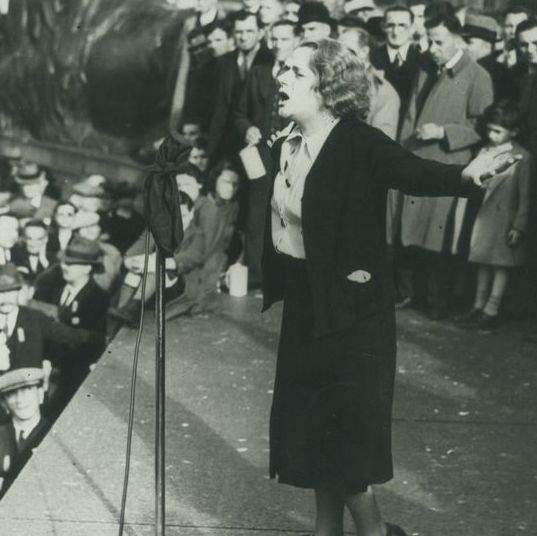I am not a lady – I am a Member of Parliament
"I am not a lady – I am a Member of Parliament." Those words could easily have been spoken by my fictional character, Mrs Siddons in Death at Crookham Hall, who I created in homage to the first women to take their seats in the Houses of Parliament.
In reality, they were said by Ellen Wilkinson, pictured speaking in Trafalgar Square at the top of this post, when a policeman attempted to prevent her from entering the House of Commons' smoking room based on her sex.
In 1924, Wilkinson was elected MP for Middlesborough East. At the time, she was the only female Labour MP and one of only four women to sit in the House of Commons. She gave her maiden speech on 10 December 1924, addressing the need for votes for all women.
Like the fictional Mrs Siddons, the press paid a lot of attention to Ellen Wilkinson’s appearance. Ellen had bright red hair and wore vivid clothing. She told fellow MPs: "I happen to represent in this House one of the heaviest iron and steel producing areas in the world - I know I do not look like it, but I do."
It was a problem that MP Nancy Astor had faced, leading her to adopt a political uniform of dark jacket and skirt, white blouse and tricorn hat.

Lady Nancy Astor (1879 - 1964)
The Parliament (Qualification of Women) Act 1918 was passed on 21 November 1918, allowing women over the age of 21 to stand as Members of Parliament for the first time.
At only 27 words, it’s the shortest UK statute. It states:
A woman shall not be disqualified by sex or marriage for being elected to or sitting or voting as a Member of the Commons House of Parliament.
It allows any woman over the age of 21 to stand for Parliament. However, in February of that year, the Representation of the People Act 1918 only gave the right to vote to women over the age of 30 who met certain property qualifications.
As a result, a number of women under the age of 30 stood for Parliament despite not yet having the right to vote in an election.
A general election was called immediately after the Armistice that ended the First World War and was held on 14 December 1918.

Constance Markievicz (1868 - 1927)
The first woman elected to Parliament was Constance Markievicz, an Irish politician, revolutionary, nationalist, suffragist and socialist. In the 1918 General Election, she won 66% of the vote in the Dublin St Patrick's constituency.
However, Constance was a member of Sinn Féin and, following their abstentionist policy, did not take her seat in the House of Commons. She was also in Holloway Prison at the time, jailed for her part in anti-conscription activities.
In 1919, Lady Nancy Astor became the first woman to sit as an MP in the House of Commons, replacing her second husband, Waldorf Astor, as the Conservative MP for Plymouth Sutton following a by-election for his vacant Parliamentary seat.
In the 1918 general election, 17 women stood for election, consisting of only one per cent of the total candidates.

Young women vote for the first time in 1929 general election
When the Equal Franchise Act became law in 1928, giving women the vote on the same terms as men for the first time, it set the scene for the 1929 ‘Flapper Election'.
Sixty-nine women stood in this election, still only making up 4 per cent of the total candidates.
In the decade before the 1929 general election, 13 women had taken their seats in the House of Commons. Seven of these women had inherited their husband’s seat or, in Margaret Wintringham's case, taken over her deceased husband’s seat in 1921.
After the 1929 Flapper Election, there were 14 female Members of Parliament, 9 of them in the Labour Party, but this still comprised only 2.3 per cent of all MPs.
Before this, the 13 female MPs were mostly middle-aged and from fairly affluent backgrounds. But many of this new influx of female Labour MPs were younger and from working-class backgrounds, driven by class injustice as well as sexual inequality.

Ellen Cicely Wilkinson (1891 - 1947)
Nicknamed Red Ellen, Ellen Wilkinson came from a poor Manchester family and described herself as a ‘flaming socialist’. The Woman's Leader called her a 'vigorous, uncompromising feminist and an exceedingly tenacious, forcible and hard-headed politician'.
In the suffragette journal The Vote, Ellen wrote that: ‘the woman who earns her living, whether as a wife or a wage earner…is suffering mainly from the wrongs that afflict all her class’.
These women challenged polite society’s perception of what an MP should look and sound like. In the words of Ellen Wilkinson, “I am not a lady – I am a Member of Parliament.”

